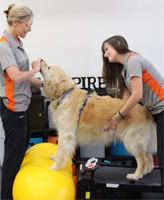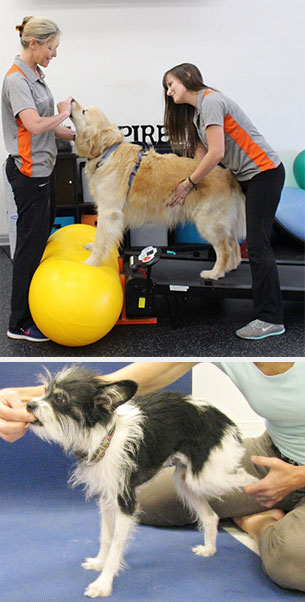
Canine physical therapy

Top:
Photo by Elaine Sichel
Karen Atlas, a physical therapist certified in canine rehabilitation, aided by Jill Lake, works with Rocky to strengthen his core and hind limbs by balancing on a peanut ball while walking on a treadmill. Rocky was hit by a car and initially was quadriplegic.
Bottom:
Photo by Dr. Janet Van Dyke
A patient is guided through balancing exercises designed to strengthen the core.
After a yellow Labrador retriever named Oliver Appleton had surgery on both knees, he underwent a physical therapy regime that looks as advanced as any human equivalent. Oliver received laser therapy and massage, and did strength and balance work on stability balls and an underwater treadmill.
Oliver belongs to Joanna Kerns, an actress and director, but the therapy he received is not reserved only for Hollywood celebrity dogs. Sports medicine and rehabilitation/physical therapy are growing fields in veterinary medicine, driven by pet owners such as Kerns, who are looking for broader options in extending the quality of life, mobility and comfort of animals they regard as family members.
“For many, many years, owners have sought help. They are driving the field,” said Dr. Julia Tomlinson, a certified canine rehabilitation practitioner in Burnsville, Minnesota, and president of the American College of Veterinary Sports Medicine and Rehabilitation.
The past two decades have seen the expansion of animal rehabilitation-related education, training and certification programs at veterinary schools and independent programs; the establishment of board certification in veterinary sports medicine and rehabilitation (there currently are 216 active diplomates, 141 of them in the United States); and the authorization this year of a veterinary technician specialty in rehabilitation therapy. In addition, animal rehabilitation equipment makers are promoting their products to veterinarians and consumers, and many pet insurance companies offer coverage for rehabilitation therapy, all of which further spurs demand.
Along with these developments in the veterinary world, physical therapists trained to treat human patients have been pursuing education and training in animal rehabilitation therapy. They're hanging out shingles as “animal physical therapists,” and seeking a greater role in veterinary medicine. (A video of Oliver Appleton's rehabilitation course is part of a promotional effort of the California Association of Animal Physical Therapists.)
Letters

These developments have raised concerns among veterinarians, compelling state professional boards and associations to sort through the sometimes competing claims and interests of the two medical disciplines. The conundrum is how to balance the skills and expertise of veterinarians, who are specifically trained in non-human animals; and physical therapists, who are experts in rehabilitation therapy but trained primarily on people.
At the same time, conventional veterinary medicine is lagging in recognizing the promise of physical rehabilitation for its patients, some in the field say. “Regular veterinary medicine doesn’t seem to understand what we do,” Tomlinson said. “We are in a situation of catch-up.”
Most states' laws are silent
To date, 30 states do not specify anything about “physical therapy” in their veterinary medical practice acts, according to the American Veterinary Medical Association.
Thirteen states specifically define physical therapy as part of the practice of veterinary medicine and/or specify that veterinarians must directly supervise animal physical therapists. The states are Florida, Georgia, Illinois, Iowa, Maine, Mississippi, Tennessee, Indiana, Louisiana, New Mexico, Oklahoma, Pennsylvania and South Carolina.
Seven states have adopted some version of an “indirect-supervision” model for animal physical therapy. They are Oregon, Colorado, Nebraska, Utah, Virginia, Nevada and New Hampshire. These states allow licensed physical therapists with defined training, experience and certification to perform physical/rehabilitation therapy on animals with the clearance or referral of a veterinarian. The therapy can be administered away from a veterinary clinic and without direct supervision by a veterinarian.
This April, after a long and contentious process, the California Veterinary Medical Board (CVMB) rejected a task-force-proposed indirect-supervision model for that state. Now the board will examine regulation changes to specifically require that a veterinarian directly supervise anyone providing animal physical therapy who is not a registered veterinary technician.
In July, the New Jersey Veterinary Medical Association successfully fought efforts to add “animal physical therapy” to the state’s physical therapy licensing act. The association is urging policymakers to follow California’s lead in restricting the practice of physical therapy on animals to veterinarians or their employees, according to NJVMA member Dr. Peter Falk.
Veterinarians who advocate restricting the practice of physical therapy to veterinary premises argue that it is the only way to ensure the health and well-being of the animals.
During the California veterinary board hearing on the topic in April, several veterinarians, veterinary technicians and members of the public testified about instances in which rehabilitation therapy went wrong but veterinarians on the premises intervened to save an animal; or veterinary intervention avoided a crisis in the first place.
Susan Abel, a firefighter from Oakland, tearfully recounted the story of her dog Gretchen, who was diagnosed with bone cancer in 2010. Abel sought physical therapy and rehabilitation, including electric stimulation, massage and hydrotherapy, to help alleviate Gretchen’s pain. During a hydrotherapy session, Gretchen collapsed.
According to Abel, veterinary staff intervened immediately. An X-ray revealed the cancer was systemic, and Gretchen was stabilized so that family could gather to say their goodbyes.
“Had Gretchen been receiving this care from a human physical therapist instead of a registered veterinary technician at a veterinary hospital and under the care of a veterinarian, Gretchen’s story would have had a quite different outcome,” Abel told the board. “She would have suffered greatly.”

Dr. Erin Troy, a Northern California veterinarian specializing in rehabilitation, sports medicine and pain management, has for more than a decade resisted efforts to allow indirect supervision for animal physical therapists in the state.
“Not one person throughout this entire process has demonstrated that a veterinary patient is safer without a veterinarian on the premises. Not once,” Dr. Troy told the panel. She said that over the years, she’s presented evidence that many of her patients are fragile and have complex conditions. “If a veterinarian is not present they … will not receive the full benefit of rehabilitation therapy.”
Pet insurance also comes down on the side of veterinary supervision, although exactly what constitutes supervision isn’t always clear. Nationwide, the largest seller of pet insurance in the U.S., covers physical therapy prescribed by the patient's veterinarian but does not specify where the service be performed. By comparison, Petplan's rules for coverage are more explicit: The therapy must be performed by a veterinarian or under veterinary supervision and at a facility with a licensed veterinarian on staff.
Proponents of indirect supervision say their proposed language for California acknowledged the critical role of the veterinarian. It gave veterinarians full control over animal patient care and the rehabilitation plan, which could include not referring to a physical therapist at all.
They also point out that the crisis examples presented during the hearing took place in direct-supervision scenarios, and that the concerns have not been borne out in states with indirect supervision.
“After 73-plus aggregate years of practice, no consumer complaints or disciplinary actions have been taken against a physical therapist in a state that operates under an indirect-supervision model,” said Karen Atlas, a task force member and an animal physical therapist who owns a rehabilitation center in Santa Barbara. Atlas provided copies of her correspondence with state agencies confirming this contention as of June 2016.
Annemarie Del Mugnaio, executive officer of the CVMB, said the agency has not verified Atlas’s information or independently asked state boards in indirect-supervision states about complaints or enforcement actions. “Does the absence of a complaint mean there’s not harm?” she asked rhetorically. “This is just one measure. What we look at is the potential for harm.”
Deferring to physical therapists
Not every veterinarian agrees with the position that that they are the only and best answer to animals’ physical-therapy needs.
Dr. Bonnie Brown, a veterinarian and certified canine rehabilitation practitioner in New York City, argues that physical therapists often are better positioned to go into animal physical therapy than veterinarians.
“Veterinarians receive more extensive training in the medicine and surgery of veterinary patients, but physical therapists spend years being trained in the specifics of normal and pathological conditions associated with joints, bones, muscles, tendons, ligaments and nerves,” Brown wrote in a letter to California’s Animal Rehabilitation Task Force. “They are taught how to recognize and treat neuromuscular and musculoskeletal pathologies. I would say they are significantly more skilled at this part of the practice. Their palpitation and manual therapy skills are exceptional, which is something we as veterinarians are never even taught.”
Jennifer Brooks agrees. A licensed physical therapist in Hollis, New Hampshire, Brooks is certified in animal physical therapy and teaches animal rehabilitation at the University of Tennessee's certification program. She said, "Many veterinarians wish to learn the art of rehab from PTs while in the certification program … that is why they are attending."
In her experience, veterinarians understand what they need to learn, and physical therapists are eager to collaborate and share their understanding. “We want to work in conjunction with DVMs, through referral process,” Brooks said, “similar as to how we work in synergy with MDs in the human-medicine model.”
Dr. Janet Van Dyke experienced that synergy when her career as an orthopedic veterinary surgeon took a bit of a detour early on. While completing a surgical residency at Animal Medical Center in New York, Van Dyke often treated dogs that belonged to physical therapists. As she explained the typical veterinary discharge instructions for their pets, she said, “They would look at me quizzically and say, ‘If this was a child, here’s what we’d do.’
“I started to say, ‘Tell me more, what can we do to do better?' ”
Their input inspired Van Dyke to pursue more education in physical therapy. She began doing less-invasive procedures, as well as more pre-habilitation and post-operative rehabilitation with what she reports as great results. She became so convinced of the value of physical therapy in the veterinary setting, she established the Canine Rehabilitation Institute in Wellington, Florida, in 2003.
While many veterinary colleges have rehabilitation clinics and include some rehabilitation in their curriculum, the majority of those in the field have completed one of the two animal rehabilitation certification programs affiliated with a university in the United States.
The first was started in 2000 at the University of Tennessee (UT) in Knoxville by Dr. Darryl L. Millis, a professor in small animal orthopedic surgery, and David Levine, a professor in the physical therapy program at UT Chattanooga. The program focuses on canine and equine rehabilitation therapy.
The second is the Canine Rehabilitation Institute (CRI), which has training facilities in Florida and Colorado, as well as in Europe, South America and Australia. It is affiliated with Colorado State University.
Both programs offer certification for physical therapists, veterinarians, veterinary technicians and physical therapy assistants. Each 120-hour program blends online classes with classroom and laboratory work, as well as externships. Neither program is accredited because an accreditation body does not yet exist for this emerging field. The programs are included in the Registry of Approved Continuing Education (RACE), which is the industry standard for veterinary continuing education.
Effects on consumer access debated
Indirect-supervision proponents argue that states can require additional education and experience in their laws if they believe current programs don’t go far enough. New Hampshire, for example, requires that animal physical therapists attend a university-affiliated certification program and complete at least one year working with human patients before working with veterinary patients.
Atlas, the animal physical therapist in Santa Barbara, California, argues that direct-supervision rules discourage physical therapists from entering the field, thereby reducing consumer access.
“If the legislature passes a direct-supervision model … fewer PTs would go into the field, if they are relegated to being an ‘aide’ for the vet,” said Atlas, whose practice has a managing veterinarian onsite.
Lee Heller, a former member of the California veterinary board and the Animal Rehabilitation Task Force, shares the worry that direct supervision will impede growth in the field. An animal rights activist in Santa Barbara and self-described “high-volume consumer of veterinary medicine,” Heller has rescued more than her share of orthopedic cases, and has come to rely on physical therapy for animals.
“My ultimate point is balancing animal protection and access as a consumer and an animal lover,” she said.
Proponents of direct supervision argue that concerns about access are overblown. Falk in New Jersey says enough rehabilitation operations exist on veterinary premises in his state to meet the need there. California’s Del Mugnaio says lack of access may be an issue in some rural areas, but that’s also true of other veterinary specialties and niches. “I think this comes down to consumers having to probably drive a distance,” she said.
One way to assess access is by examining where animal rehabilitation is available. The picture comes up mixed; it depends on how you slice the data.
In pure numbers, many direct-supervision states rank high in animal rehabilitation practitioners. Based on figures derived from the "find a therapist/practitioner" links of the two main certification programs, CRI and UT, and looking at the 20 states that specify either direct supervision or indirect supervision, seven direct-supervision states rank among top 10 for the greatest number of certified practitioners (veterinarians, physical therapists and veterinary technicians alike).
However, when factoring in states' populations, the rankings change markedly. Looking at the greatest number of practitioners per capita, four indirect-supervision states rank among the top five.
No. 1 is Colorado, which has allowed indirect supervision since 2007. It has one certified animal rehabilitation practitioner per 65,000 people. The state with the fewest practitioners per capita is Mississippi, a direct-supervision state, where the ratio is one to 597,745.
Among the seven indirect-supervision states, the median ratio is one practitioner per 158,713 residents. Among the 13 direct-supervision states, the median ratio is one practitioner per 310,070 residents.
The per-capita ratios in California and New Jersey, which are working out their rules, are one per 356,818, and one per 308,430, respectively.
Editor's note: This article has been changed from the original to correct the number of American College of Veterinary Sports Medicine and Rehabilitation active diplomates.